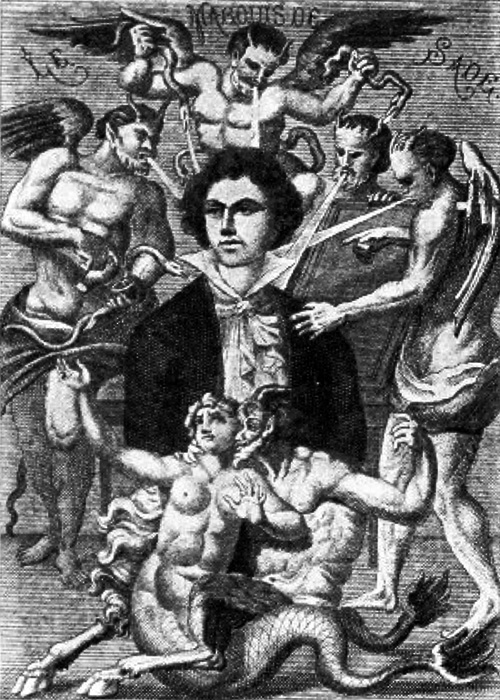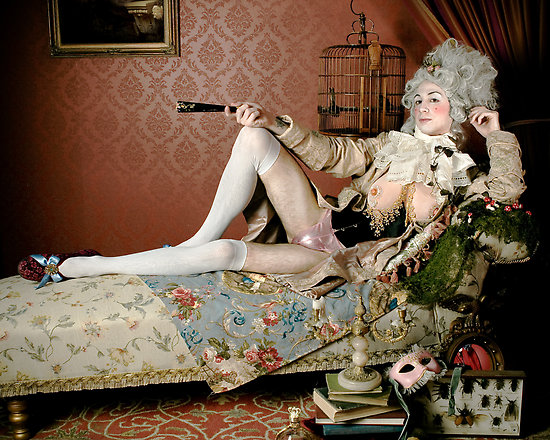by Violet Midnight
Most people have a vague idea that sado-masochism (or as it is sometimes written, sadomasochism or sado/masochism) is named for two people; one of them into inflicting pain (sadism) and one of them into having pain inflicted (masochism). These two men are The Marquis de Sade, born in 1740 and author of many erotic writings including, most famously, Justine, about a man who enjoys inflicting pain upon his mistress. Leopold von Sacher-Masoch, born in 1880, also wrote erotic stories, the most famous of which was called Venus in Furs in which he describes being whipped by a woman while grovelling at her feet dressed in furs like a dog.
The pleasure/pain dyad was certainly not unknown before this however; as far back as the Middle Ages, many Christian people flogged themselves as punishment during the plague. These “flagellants” took the Black Death to be a sign from God that the end of the world was near. They would process through the streets of towns, beating themselves with chains, rods and sticks, and scourging their flesh. They thought they could atone for their sins through pain, and be spared death by plague, or at the very least, gain God’s forgiveness before death in this way. Regardless of whether these flagellants felt sexual pleasure in this pain (and no doubt some of them did), they did take pleasure in the way their self-inflicted pain brought them closer to God.Illustration of a Dutch printing of the book Juliette by the Marquis de Sade, c. 1800
It was many years later when psychologists first associated these names with these practices. Dr. Krafft-Ebing, a Victorian era psychiatrist, used Sacher-Masoch’s name to create the word “masochist,” to define a new form of sexual psychopathology in which someone derives sexual pleasure from the infliction of pain. He considered this an abnormal, anti-social urge. Fellow Victorian, Austrian doctor Sigmund Freud, first combined the word sadism (after the Marquis De Sade) and masochism into sadomasochism to define people who got sexual pleasure from giving and or receiving pain; for Freud these urges and practices were similar enough that they could be grouped together, even though it should be fairly obvious that these urges and what motivates them are very different!
or the Victorians, sex was not about pleasure; it was something women had to endure, and men must indulge in it only for procreation. It was considered unhealthy and masturbation was actually seen as life-shortening. Various devices were invented to prevent the discharge of semen, like locked penis cages or spiked rings that made erections very painful. But the repressiveness of the Victorians found other outlets. Queen Victoria had a long reign and the premature death of her husband caused her to This was the era in which discipline in public schools became very widespread. Boys at the height of sexual development were beaten or flogged for misbehaving, or when caught masturbating or experimenting sexually with each other, and as a result many men grew up to have a taste for sado-masochism, associating it with sexual pleasure. One famous brothel in England was run by a woman named Theresa Barkley. Her “house” contained all kinds of S/ M instruments of torture, some of which were very elaborately constructed. The Barkley “horse” was built for a man to stand or sit on and could put his penis through a small hole and the madam would cane him or beat him as he desired. Clearly this combined elements of bondage and domination as well as S/M.
The Victorian era effectively ended with World War I. But Europe’s fascination with the secret expression of sadomasochistic urges appeared in other places, notable Germany. The Berlin of the 1920′s embraced every expression of the imagination, and this open minded society, comprised of poets, nude dancers, vegetarians and sexologists, embezzlers, magicians and prophets, often found expression in the cabaret: a vibrant club where performance, drinking and drug use, and public sex were all the norm.The cabaret culture was amused by the seriousness of the Hitler regime and before the second world war began, took advantage of their public forum to ridicule the government and what they perceived as the arrogance and repressiveness of Germany’s rulers.
The war changed everything. But sadomasochistic imagery began to slowly reappear in German cinema after the war, as well as in other art and performance forms. Ideas having to with liberating the subconscious mind (ideas that were finding their way to the United States, too, and arrived with the Beatniks in the 1950s) encouraged free sexual expression, too. In the 1940s, psycholanalyist Erich Fromm fled Germany for New York City, and published “Escape from Freedom”. Among other controversial ideas explored in this book, Fromm stated that we cannot bear freedom and so we wish to give up our freedom by submitting ourselves to new forms of authority.
This compulsion to escape freedom turns us against ourselves. Some theorists believe this idea resurfaced very pervasively in the 1990s, with the new emphasis upon capitalism and corporate-driven greed and consumerism. Commodification of everything, including the body and leisure pursuits, led many to find plain old sex borning and led many “mainstream” people to explore sado-masochistic practices. I remember a cover of New York magazine with a woman dressed in leather bondage gear, with the headline: “In the 1970s we had Free Sex; in the 1980s it was Safe Sex; Now We have Mean Sex.” This was evidence that S/M had reached the mainstream culture, and alongside the very repressive attitudes about sexual activity expressed by the growing religious right wing, we now have a culture that is simultaneously as experimental and expressive sexually as it has ever been, but also as repressed and sexually-conservative as it has ever been.
Perhaps because of its European origins, sado-masochism has been most prevalent in practice in Europe and particularly in Germany. Laws which are associated with sex and morality in some European countries are comparatively lax when measured against the puritanical attitudes of the United States, and many groups, clubs and events for those interested in sado-masochism have existed there for decades. Amsterdam in the Netherlands is also famous for its sex clubs and open-minded attitudes.
It was in the 1980′s that another term was created that is associated with S/M (another way of referring to sado-masochism, which most people say aloud as “S and M” but spell it S/M) is BDSM, or bondage, domination, sadism and masochism. Bondage refers to the use of restraints, handcuffs, ropes, suits and masks to restrict movement, which some find sexually exciting. Some of these practices came to the USA from sex clubs in Europe and became particularly popular in some of the gay bars in New York City and San Francisco in the 1960s and 70s. The subculture of both male and female homosexual communities that practice BDSM are usually referred to as “leather” as in “leather dykes” or “leather boys.” Bondage “gear” can be custom made to fit one’s own body and head and many like to have this clothing and equipment custom made for them out of fine leather; many leather crafters specialize in creating this type of clothing which can be very expensive. In the 60s and 70s the only place to find like-minded bondage aficionados was at clubs or bars, or in ads placed in magazines. But these days the internet has made it very easy for people to find each other, and of course has made it necessary for people to be cautious with anonymous interactions before meeting people in person.
Domination refers to dominance/submission: some people like to be dominant in sex, and some like to be submissive. Sometimes these relationships involve forms of humiliation, as when a dominatrix (professional female dominator) orders a man to dress in baby clothes or behave like a dog. There are also male “doms” who like having female “subs” or submissives. Sometimes BDSM play involves pain or varying levels of discomfort. Leather flails or paddles can be used for spanking, or some like hot wax dripped on the skin. People who take part in this sort of sex play tend to follow very specific rules created by practitioners over the years. Most practitioners suggest choosing a “safe word” (a non-sexual word not normally used in sex play, like “strawberry” or “newspaper”) to be used when play gets too intense and one participant wants to pause and shift things to a more comfortable level. It is recommended that people interested in this kind of play explore the literature available so they can do so safely and in ways familiar to the people in this community (and a very large community it is!)
These days, even while it is very easy to find other people who practice BDSM, some only express themselves in this lifestyle online; such people might be called “cyber-doms” “cyber-subs.” People who have been involved in BDSM for a longer time (before the internet) tend to think it is not as authentic or “pure” as being in a BDSM persona or lifestyle 24 hours a day, seven days a week. But because these practices now attract so many people and BDSM is such a huge industry, most enthusiasts think freedom of choice (and of course, personal responsibility) is what should govern their involvement with it.
For a very thorough historic timeline of important events in the history of sadomasochism, CLICK HERE. Many of the more contemporary events are related to German culture but they still offer a fascinating and thorough glimpse into this lifestyle.




